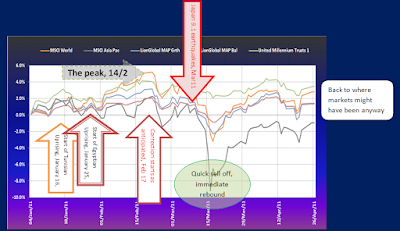Financial Markets - Signs of Disarray, Short Term
It's been two weeks+ since my last comments, - a therapeutic pause no less.
Since mid January all considerations of what fundamental reasons might be valid for investing here and there have been put aside and a simply opportunistic approach pervades global financial markets.
 |
| Indian BSE- down to major support, ready for a rise? |
We can observe this phenomenon in Indian stock markets, Indonesia and even the STI. Foreign investors are taking profit, regardless of the underlying positive fundamental outlook. In considering the risk - reward environment of investing in their own stock markets with a reasonably stable US$, versus investing overseas, they choose the US markets. In the end, its ok as the ongoing QE should really benefit the US first and foremost, instead of creating a "hot money" ballooning effect and oversized share valuations in Asia.
This I believe has created the last three weeks of incoherent market movements globally. Of course, there are already some, who now think that the US markets are starting to be expensive. If you look at our asset allocation model, you will note that we envisaged February to be a low point, possibly for the year. So any weakness now - wherever it occurs -, probably presents a good buying opportunity, demanding a renewed focus on the main trends for the year.
In the last four weeks I went through heaps of forecasting and report material from a wide range of commentators. What bothers me not (this time!) is that there is almost 100% consensus about where markets are headed in 2011: UP! However, the reasons given for such an outcome a quite varied and this is where it becomes interesting.
In recent seminars, I propagated one particular aspect as key: I said, it would be inflation driven. To keep it simple I suggested that in the developed world, we would see inflation as a consequence of the ever increasing liquidity, while in emerging markets and Asia the story is more one of economic expansion and the "naturally" evolving inflation that comes with increasing wealth, and the school book rules of supply and demand.
It is of course only a question of time, when the growth drivers in Asia start generating positive economic activity in the US and - a little later in the Euro Zone. Typically, Europe is lagging the US economies by 6-9 months. It will probably take half a year to stabilise the credit and financial environment in Europe, too. What this means is that this year may see more frequent asset rotation as and when Big Investors reevaluate risk and reward rather more closely.
More tricky is the outlook as far as purely fundamental economic drivers is concerned: anyone thinking that by investing in China (as the main economy) will produce some fireworks in their portfolio performance will probably be sorely disappointed. Why do I say that? Well, the Chinese authorities are keen to keep speculation in Chinese (Mainland) stocks to a level that is relevant to the real growth in the country. They are less bothered with the Hang Seng and stocks listed on other exchanges. Hence, from a foreign investor point of view, a pure focus on Mainland China stocks is not really beneficial, - and even on the choice of China funds, you may be better off choosing a "Greater China" version. While I wholeheartedly agree with the view that Chinese markets are poised to increase this year, investors probably find extracting sensible returns cumbersome. Personally, I prefer peripheral Asian markets, as I expect to find less headwinds - and easier gains.
More soon. Happy Investing!





Comments